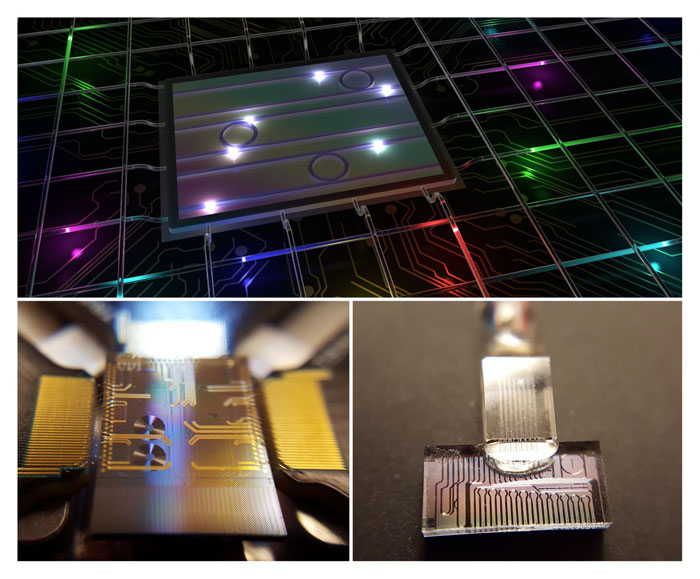A photonic system created using a lightweight, inexpensive photonic chip and off-the-shelf telecommunications components has been used to demonstrate that photons can become an accessible, powerful quantum resource.
Integrated photonics has become a leading platform for the compact, cost-efficient, stable generation and processing of nonclassical optical states. However, so far, integrated entangled quantum sources have been limited to qubits (D = 2).

Top: High-dimensional color-entangled photon states from a photonic chip, manipulated and transmitted via telecommunications systems. Photonic chip including a nonlinear microgravity, used to generate color-entangled photon pairs (left). Photonic chip connected to optical fiber, allowing the quantum state manipulation with standard telecommunications components (right). Courtesy of Michael Kues (top image) and INRS University.
Researchers at Institut National de la Recherche Scientifique (INRS) have demonstrated on-chip generation of entangled quDit states, where photons were created in a coherent superposition of multiple high-purity frequency modes. The photons were generated in the form of color-entangled quDits using a photonic chip that was fabricated through processes similar to those used for integrated electronics.
With an on-chip micro-ring resonator excited by a laser, photons were emitted in pairs that shared a complex quantum state. The photons were constructed in a state featuring a number of superimposed frequency components: They were several colors simultaneously; and the colors of each photon in a pair were entangled, regardless of their separation distance.
With each frequency (i.e., color) representing a dimension, the photons were generated on-chip as a high-dimensional quantum state (quDit).
Further, using standard telecommunications components, the team developed a coherent manipulation platform with which to control frequency-entangled states, capable of performing deterministic high-dimensional gate operations. The team validated this platform by measuring Bell inequality violations and performing quantum state tomography.
The research team, led by professor Roberto Morandotti, has confirmed the realization of a quantum system with at least one hundred dimensions, formed by two entangled quDits with D = 10. The team believes that its system could be extended to create two-quDit systems with more than 9000 dimensions (corresponding to 12 qubits and beyond, comparable to the state-of-the-art in platforms that are significantly more complex and expensive).
Use of the frequency domain for such quantum states could enable their easy transmission and manipulation in optical fiber systems.
“By merging the fields of quantum optics and ultrafast optical processing, we have shown that high-dimensional manipulation of these states is indeed possible using standard telecommunications elements like modulators and frequency filters,” said professor José Azaña.
Researchers Michael Kues and Christian Reimer also note that the demonstrated platform is highly accessible: It is easy to build and exploits components that are commercially available. Thus, in the short term, researchers around the world could use the platform to move the technology forward, enabling a potential leap in the development of practical quantum applications.
Many previous advances in technologies for the telecommunications sector have targeted the manipulation of classical signals. The INRS research could enable fundamental investigations of high-dimensional quantum state characteristics, leading to applications in large-alphabet fiber-based quantum communications, future development of frequency-domain, high-dimensional quantum logic gates and other applications.
The research was published in Nature (doi:10.1038/nature22986).
Generation of color-entangled photon states on a photonic chip and their coherent control via standard telecommunications components. This animation gives an overview of the approach used in the research. Courtesy of Benjamin Maclellan.